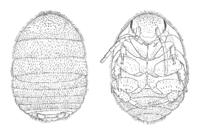Attaphila fungicola
| Attaphila fungicola | |
|---|---|

| |
| Scientific classification | |
| Kingdom: | Animalia |
| Phylum: | Arthropoda |
| Class: | Insecta |
| Order: | Blattoidea |
| Family: | Ectobiidae |
| Genus: | Attaphila |
| Species: | A. fungicola |
| Binomial name | |
| Attaphila fungicola W.M. Wheeler, 1900 | |
There are nine species of myrmecophiles in the genus Attaphila.
Diagnosis
- Male As in A. paucisetosa with specialisations on T2 (msl2, but these are narrower, with simpler ridges), distinguished by having dispersed surface bristles on T2–5. For differences to A. flava, see 4.3.
- Female: Well characterized by the combined occurrence of two characters: T2–5 with dispersed surface bristles, T6,7 with only few and small surface bristles. The latter feature is also shared by A. paucisetosa, in which, however, the surface bristles of T2–5 are arranged in one line.
Description
Distribution
Colombia, Guyana, Panama, Trinidad, United States (Texas, Louisiana)
Biology
While the Orthoptera, as a rule, are large or medium-sized insects, both Myrmecophila and Attaphila are so far below even the average stature of insects of this order that we must conclude either that they have become reduced in size secondarily in adaptation to their present habitat and companionship, or that they were originally diminutive species, and, for that very reason, better able to enter into symbiotic relationship with the ants. The latter alternative seems to be the more probable
Ant host: Atta texana.
Attaphila fungicola is a miniature cockroach that lives in the deep, subterranean nests of leaf-cutter ants, a symbiont of the leaf-cutters and their mutualist fungal gardens. The only conspicuous glimpse we get of A. fungicola dispersal is at the beginning of their journey, during the nuptial flight preparations of leaf-cutter colonies. During these preparations, A. fungicola hitchhikes on the colony’s female alates (winged queens), which, if successful, will mate mid-air with male alates, land and begin new leaf-cutter colonies as foundresses (workerless queens). Hitchhiking on female alates has long been interpreted as a roach behavior facilitating dispersal to incipient colonies of foundresses; however, incipient colonies likely represent much lower quality habitats than larger established colonies, and roaches may benefit by avoiding the former during dispersal in favor of arriving at the latter.
REFERENCES
- Rodríguez JG, Montoya-Lerma J, Calle Z (2013) First record of Attaphila fungicola (Blattaria: Polyphagidae) in Atta cephalotes nests (Hymenoptera: Myrmicinae) in Colombia. Bol Cient Mus Hist Nat Univ Caldas 17: 219–225.
